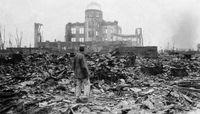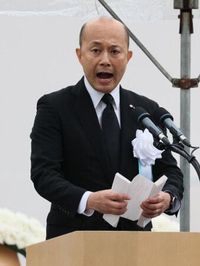On August 6 and 9, 2025, the world paused to remember one of the darkest chapters in human history: the atomic bombings of Hiroshima and Nagasaki. As the 80th anniversaries of these devastating attacks were marked, calls for nuclear abolition grew louder, underscored by urgent warnings from survivors, city officials, and global activists who fear that the world is once again edging dangerously close to the brink.
In Nagasaki, a city forever linked to the horrors of nuclear war, thousands gathered at Peace Park on August 9 to observe a moment of silence at exactly 11:02 a.m.—the precise time the bomb detonated in 1945. Survivors, known as hibakusha, families of victims, local officials, and representatives from about 90 countries joined together in solemn remembrance. Among them was Nagasaki’s mayor, Shiro Suzuki, whose own parents survived the bombing. His words, delivered in this year’s Nagasaki Peace Declaration, resonated far beyond the city’s boundaries.
“Procrastination can no longer be tolerated,” Mayor Suzuki declared, urging world leaders to show a clear path toward nuclear abolition at the upcoming 2026 Nuclear Nonproliferation Treaty (NPT) Review Conference. He did not mince words about the stakes: “An existential crisis of humanity has become imminent to each and every one of us living on Earth.” According to Jiji Press, Suzuki called for an immediate ceasefire in armed conflicts worldwide and stressed, “We must never allow even a single person among the people of the world and the children to be born in the future to go through the death and suffering caused by nuclear weapons that hibakusha have suffered.”
This year’s ceremony in Nagasaki was notable for its broad international participation. For the first time, Taiwan attended, and countries previously excluded—Russia, Belarus, and Israel—were present. The event drew 4,195 people, including representatives from 94 countries and regions and the European Union. The diversity of attendees underscored the global consensus that the threat of nuclear war is not confined to any one region or people.
Just days earlier, in Kolkata, members of the Socialist Unity Centre of India (SUCI) burned an effigy of former US President Donald Trump during a rally marking the Hiroshima anniversary. The protest, as reported by IOL, was a pointed reminder that nuclear anxieties remain acute, particularly in the Global South. Trump’s “erratic nuclear threats,” the article argued, have set a “dangerous precedent for impulsive brinkmanship.” The writer, Dr. Reneva Fourie, did not shy away from criticizing the United States for its historical and ongoing role in nuclear politics, pointing to the original bombings as “an act of savagery” with “no military justification.”
Fourie’s analysis went further, questioning the credibility of the Nuclear Non-Proliferation Treaty itself. While nuclear-armed states continue to modernize and expand their arsenals, non-nuclear countries are pressured to comply or face consequences. The NPT, initially designed to halt the spread of nuclear weapons and encourage peaceful nuclear energy, is now viewed by some as a tool that entrenches the power of a few while leaving others vulnerable. The reluctance of nuclear-armed states to disarm has deepened resentment, especially in the Global South, where the legacy of colonialism and resource exploitation still looms large.
Yet, the nuclear story is not only one of destruction. As Fourie notes, nuclear technologies play a vital role in socio-economic development, particularly in Africa. South Africa, for example, has leveraged its nuclear expertise for peaceful purposes. Koeberg, the country’s oldest nuclear power station, has provided reliable, low-carbon electricity for decades. Through the SAFARI-1 program, South Africa is a global leader in producing medical isotopes used to diagnose and treat cancer. The country is also reviving its Pebble Bed Modular Reactor program to provide clean, stable power to remote or underserved areas—a potential game-changer for a continent where millions lack access to reliable electricity.
However, the promise of nuclear energy comes with responsibilities. South Africa has established a robust legal and regulatory framework, with the independent National Nuclear Regulator overseeing safety and the National Radioactive Waste Disposal Institute managing waste. Across Africa, the Pelindaba Treaty bans the development, possession, or use of nuclear weapons, requiring full-scope IAEA safeguards and prohibiting the dumping of radioactive waste. The African Commission on Nuclear Energy upholds these standards, but Fourie argues that full operationalisation of the commission and greater regional cooperation in regulation, training, and verification are urgently needed.
As a major exporter of uranium, Africa faces a unique challenge: ensuring its resources are not diverted for military purposes. Fourie calls for a unified African stance that no uranium from the continent will be used for weapons—a policy that would align with broader goals for peace, climate action, and sustainable development.
Back in Nagasaki, Mayor Suzuki’s message echoed these global concerns. He warned that the world’s continued reliance on nuclear deterrence and the slow pace of disarmament have brought humanity to the edge of disaster. Suzuki’s call for action at the 2026 NPT Review Conference was not just symbolic. He demanded “a specific course of action for achieving the abolition of nuclear weapons,” underscoring that mere dialogue is no longer enough. The mayor’s hope, shared by many in the city, is that Nagasaki will remain the last city ever to suffer an atomic bombing.
The threat of nuclear weapons today is multifaceted. The risk of accidental war, an accelerating arms race, mounting international tensions, and the specter of nuclear terrorism all compound the danger. As highlighted by the coverage in Jiji Press and other outlets, these risks are not theoretical—they are immediate and pressing. The world’s nuclear stockpiles, technological advancements, and shifting geopolitical alliances make the possibility of nuclear conflict all too real.
Despite these challenges, there are glimmers of hope. Cities like Nagasaki and Hiroshima continue to champion peace and disarmament, hosting annual memorials and education programs that keep the memory of past horrors alive. Survivors’ stories, the advocacy of peace groups, and the efforts of nations that have renounced nuclear arms—such as post-apartheid South Africa—demonstrate that change is possible when there is political will and public pressure.
As the world reflects on the 80th anniversaries of Hiroshima and Nagasaki, the message from survivors, activists, and officials is clear: prevention is the only option. The nuclear age began in devastation, but it does not have to end that way. By rejecting militarization and embracing peaceful innovation, humanity can chart a new path—one that prioritizes security, sustainability, and the sanctity of life over the shadow of annihilation.
The lessons of 1945 are as urgent now as ever. The responsibility to act rests with governments, international institutions, and ordinary citizens alike. The road to a nuclear-free world is long and fraught, but the alternative is simply unthinkable.


